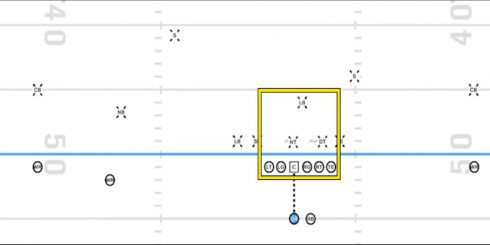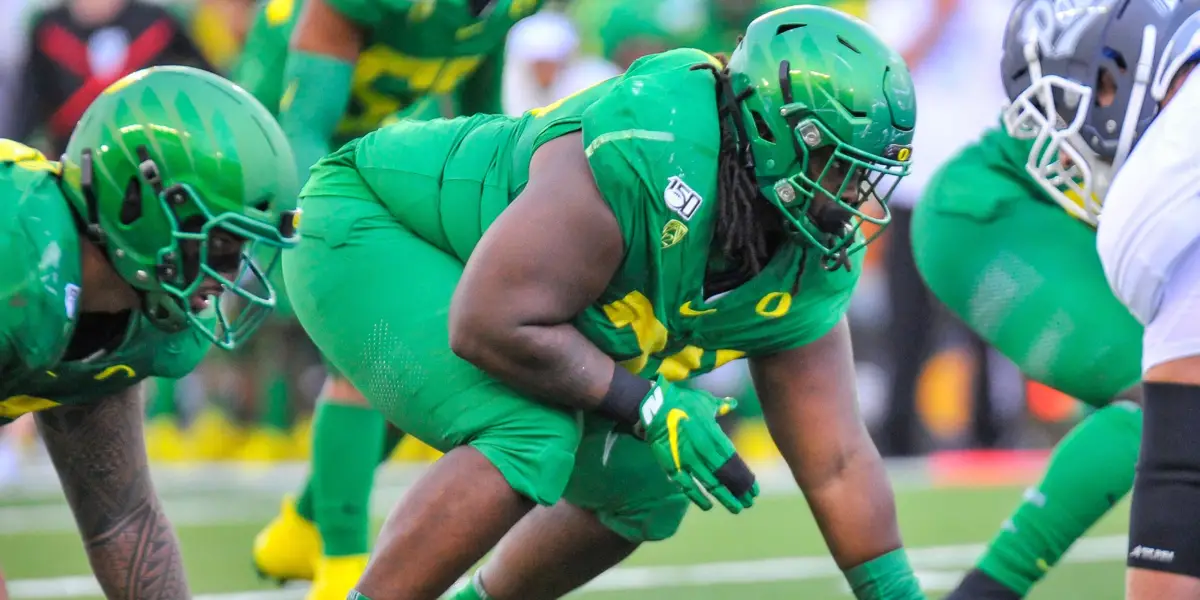Before Andy Avalos introduced his brilliant defensive schemes last fall, Oregon’s glaring weakness was its inability to defend players in space. Ducks defenders often looked like ghosts pursuing pac-men all over the football field. Former defensive coordinator Jim Leavitt shored up some of the weaknesses, but it was Avalos who put a stop to the flow of embarrassing big plays from those tortuous years.
I analyzed one of Avalos’s most effective schemes in my last article. However, I mistakenly called it a 5-1-5 defensive formation. In actuality, it was a 3-3-5, as Coach Eric Bowles pointed out nearly a year ago. But regardless of labels, this defensive formation is founded on a key element: five men squaring up hat-on-hat at the line of scrimmage.
Allow me to introduce Andy Avalos’s lethal weapon: the five-man front.
The Basics…The Box

The “Box”
Several times each game, Avalos lines up three defensive lineman inside all five offensive lineman, with two additional defenders just outside both offensive tackles (I’ll name them edge players for the sake of simplicity…one is usually an outside linebacker, the other the stud end that Coach Bowles defines and describes in this article).
This alignment is called a five-man front. The key to the alignment however, is that it IS NOT formation-specific. Let me elaborate.
Alignment Versus Formation
Here is a 1-5-5 formation:
We all recognize the key interception in the video above. But did you notice the only lineman with his fingers on the ground is Austin Faoliu? Formations are identified by the number of lineman with at least one hand on the ground. Those linemen are referred to as “down lineman.” Hence, the 1-5-5 formation we see above technically has only one down lineman but is in effect a five-man front.
In the above video, I’m unable to identify the two down lineman, but Jordan Scott, La’Mar Winston Jr., and Bryson Young are all standing up. This is a 2-4-5 formation.
In the video above, Faoliu, Gus Cumberlander, and Scott line up as the three down lineman. This is Avalos’s basic 3-3-5 formation.
Although there is a breakdown in the second video (Young drifts inside and loses control of the edge), all three videos exemplify how a five-man front naturally seals the edge of the box (in the third video, Young recognizes the statue of liberty play, sheds his blocker, and shuts down the reverse).
Forcing the flow of running plays to inside the box is one of the most important priorities of a defense, particularly of the edge lineman. But let me show you the wizardry Avalos conjures up using the front five when the unit is defending pass plays.
Tactical Advantages
The first video above displays how edge linebacker Troy Dye feigns a blitz, drifts directly into QB Jack Coan’s passing lane, and then tips Coan’s pass to Deommodore Lenoir. Check out how Keyvon Thibodeaux jets past Wisconsin’s All-Big Ten center, creating room for Mase Funa and Issac Slade-Matautia to buckle the center of Wisconsin’s pocket while Faoliu collapses the right side.
This second video above demonstrates how the five lineman are not only in position to defend an inside- or outside-zone read, but how difficult it is to determine if they will blitz or peel off into pass coverage (as Young effortlessly demonstrates on this particular play).
The third video above is a perfect example of masking who will blitz (including the threat that cornerback Lenoir will blitz) and who will drop back into pass coverage. Slade-Matautia peels back to lock down the receiver running to the middle of the field, while Cumberlander loops so far inside he freezes Auburn’s right tackle. Dye jets by the stunned RB, whom Lenoir is assigned to cover. Though Dye runs past QB Bo Nix, Lenoir picks up the pressure because he is assigned to the area. Checkmate.
Each video demonstrates how the edge players can force runs inside, blitz, stunt or drop into pass coverage. The “front five” are able to apply pressure with or without the help of the remaining six “back end” players -who can also blitz, provide run support, or cover receivers.
“Offense Offense Offense!!!”
Avalos’s schemes may appear simple, but don’t be fooled. Kayvon Thibodeaux lined up in three different positions on the line? Outside linebacker Mase Funa blitzing from the middle linebacker position? Inside linebacker Isaac Slade-Matautia covering tight ends and slot receivers from the outside linebacker position? How will teams prepare for THAT?
Spotlight-hogging offenses may have incited a tinge of jealousy on the part of past Oregon defenses. Not anymore. It is now Oregon’s defensive unit bringing the lethal firepower.
By implementing a five man front with nearly unlimited versatility, Avalos has created a truly lethal sequel to Oregon defenses of years past.
Mike West
Las Vegas, NVTop Photo by Kevin Cline

Phil Anderson, the FishDuck.com Volunteer editor for this article, is a trial lawyer in Bend Oregon.
Mike West was born in Southern California and moved to Eugene in 1976. He attended his first Oregon Football game and watched USC maul the Ducks 63-0. Despite the disappointment he became an avid fan after watching the Rich Brooks show every Sunday in the Fall. After graduating from the University of Oregon, he returned to Los Angeles and enjoyed a career in Customer Service for two decades. Thrilled at the ascent of Oregon Football, he attended both Rose Bowls, living just five miles from the stadium. He now lives in Las Vegas.

